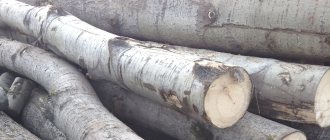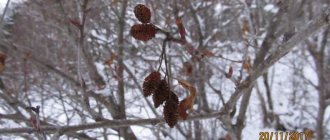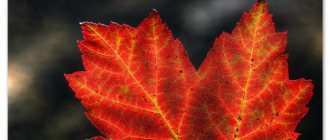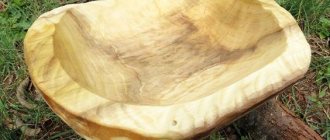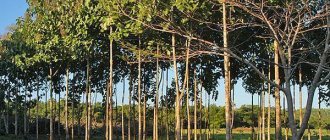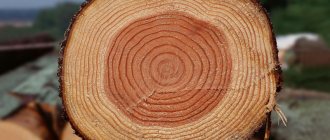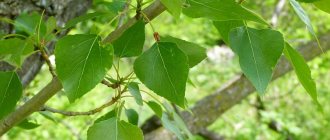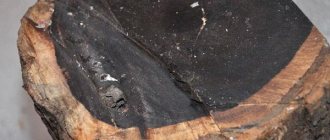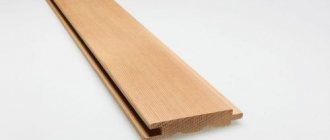Short description
Black alder grows up to 30-35 meters, the trunk diameter can reach 90 cm. In wetlands, a clump form is not uncommon, when several powerful trunks grow from one point. The branches grow at a large angle to the trunk, sometimes perpendicular. The crown is oval or pyramidal; over time, large branches are overgrown with small ones, and the crown becomes rounded.
Black alder, like gray alder, grows quite quickly, especially up to 5-10 years, and lives up to 100 years. Rarely there are specimens that have lived up to 300 years. This alder, unlike the gray species, does not have root suckers, but its root system is superficial, and also with nodules in which nitrogen-fixing bacteria live.
The bark of young alder is greenish-brown, with numerous light lenticels located across the trunk. With age it darkens, becomes black and becomes covered with cracks.
The leaves are round, most often with a notch at the top, and are located alternately on the branch. Dark green in color, with jagged edges, do not turn yellow in autumn, turning brown after falling. Young leaves are covered with a sticky substance that attracts insects.
The tree is monoecious, blooms in early spring. Male flowers are drooping catkins, while female flowers are oval on long petioles. Male flowers begin to form in the fall, and female flowers in the spring. Pollination occurs due to the wind, when there are no leaves on the tree yet, and nothing interferes with the process.
By autumn, the fruits, or oval cones about 2 cm long, ripen; in summer they are green, but in autumn they turn black. They contain nuts with a wing inside. They can be collected in the fall, but the tree itself releases the seeds into free flight only in the spring, and they are carried by wind and water.
Fruits appear annually, but not earlier than 10 years of age. Specimens growing in the forest begin to bear fruit at 30 years of age.
When to collect and how to distinguish
Alder grows in damp wetlands, along the banks of streams and rivers; gray alder and black alder are usually found. The bark of gray alder is light and smooth, while that of black alder is dark brown, with cracks. If it is difficult to distinguish by the bark, then look at the leaves. The gray alder has a sharp tip, while the black alder has blunt leaves with a small notch. In the spring, immediately after the buds open, the tender leaves of black alder are sticky and stick to your hands. This is the best time to collect them.
Cones and bark are harvested in late autumn or winter in dry weather. It is recommended to shake the branches or carefully trim them. Then the collected raw materials are dried in dry, well-ventilated places or in dryers. Raw materials are stored for no more than three years.
Chemical composition
The beneficial and medicinal properties are determined by the components in the chemical composition of black alder. Glycosides, alkaloids, flavonoids, steroids, ellagic, gallic (about 4%) and other acids, tannins of the pyrogal group (tannin (up to 2.5%), etc.), fatty oil were found in the cones.
The leaves contain flavonoid glycosides (hyperoside (13.3%) and quercetin), organic acids (caffeic, chlorogenic, protocatechinic), protein (up to 20%), fats (6%). Vitamins are represented by ascorbic acid and carotene. Triterpenoids and flavonoids are found in the kidneys.
Black alder bark contains alnein, emodin, triterpene ketone glutinone, taraxerol (alnulin), taraxerone, lupeol, tannins (up to 16%) and coloring substances, as well as vitamin PP and fatty oil, which includes palmitic, stearic and phosphoric acids etc.
Contraindications to the use of alder cones
The medicinal properties and contraindications of alder cones are closely related to each other. Sometimes infertility can harm the body. You must avoid using them in any form:
- during pregnancy and breastfeeding;
- with a tendency to constipation;
- with sluggish digestion;
- for individual allergies;
- in acute pancreatitis or open gastric ulcer.
Alder cones are offered to children only after 12 years of age. It is necessary to use decoctions and infusions in strict accordance with recipes in small dosages. If constipation, nausea and mild dizziness develop while using alder cones, stop taking the medications immediately.
Folk recipes
Leaves and buds of the black alder tree
A tablespoon of finely chopped leaves is brewed with a glass of boiling water, kept in a steam bath for half an hour or left covered for five hours. Take 1/3 cup before meals as an antitumor agent for various types of cancer. To the infusion of leaves add tincture of buds (30 drops) - five tablespoons of crushed buds are poured with vodka (500 ml) and left for a month.
Decoction of sulfur alder cones
A tablespoon, 250 ml of boiled water is simmered over low heat for a quarter of an hour, filtered cold. Drink 1/2 glass to treat the intestines, take it as a fixative for indigestion, and gargle for a sore throat. Significant improvements are observed already on the second day. Stored for 2 days.
Infusion for rheumatism
3 tbsp. Alder bark or a spoonful of cones is brewed with a glass of boiling water, and filtered after two hours. Take a tablespoon three or four times a day.
Leaves compress
Relieves pain well. Problem areas are covered with leaves, wrapped in polyethylene or a piece of natural fabric to create a greenhouse effect. The pain subsides quickly. A compress made from steamed leaves is good for mastopathy.
For diarrhea
2 tbsp. Brew a glass of boiling water, leave under the lid until it cools down. Drink 1/4 cup four times a day.
Infusion for bleeding
A handful of leaves is brewed with boiling water and drunk after fifteen minutes. The product helps against internal bleeding.
Application in cosmetology
The beneficial properties and contraindications of alder fruits are used in home beauty recipes. Cone-based products cleanse the skin, tighten pores and increase the elasticity of the epidermis. With their help you can get rid of the first wrinkles and even out your complexion.
For frequent pimples and skin irritations, it is recommended to prepare a lotion for washing:
- 10 g of plant materials are crushed;
- pour 300 ml of boiling water;
- leave for two hours covered.
The finished product is filtered and used for washing every day in the morning and evening. Procedures must be carried out until the skin condition improves.
Alder cones are beneficial for weakened hair, as they strengthen the roots and nourish them with valuable substances. To care for curls, prepare a simple rinse:
- 45 g of infructescences are poured into a thermos;
- pour 500 ml of boiling water;
- stand for three hours;
- strain the product.
It is necessary to rinse your hair with this infusion every time after washing. In addition, for ten days, the product is rubbed into the root area every evening and left overnight.
A decoction of alder fruit helps normalize oiliness at the hair roots
Where is alder used?
This breed has a smooth trunk and thin bark. The array is amenable to mechanical processing and factory deformation. The wood after drying is quite strong and durable. It does not splinter from self-tapping screws, but is vulnerable to thin metal nails.
Before use, the wood needs to be thoroughly cleaned of knots and dried. If you neglect this requirement, then the likelihood of voids appearing inside the array increases. In the future, this will affect the performance of the wooden product.
The material is used in the production of bridges, rafts and wooden ships. Solid alder is used for finishing work. The material requires additional treatment with antifungal compounds.
The wood has a beautiful texture and durability. More often, solid wood is used for the manufacture of furniture paraphernalia. The products are durable and wear-resistant. The surface needs additional varnish protection. This helps emphasize the depth of textured lines and the color of the furniture.
The shavings are used for the production of chipboard and MDF panels. The products are resistant to moisture. The material contains a large amount of resin. It repels harmful insects and prevents rotting processes.
Pests and diseases
- Like all living things, sticky alder is also capable of getting sick, and it also has its own parasites; Taphrina is one of these pests. It causes scales to appear on the female earrings, damaging them.
- Taphrina alni is another specimen from the same family, it forms what is popularly called “witch’s broom”, these are a number of clusters of small shoots that have sprouted from dormant infected buds. The leaves shrink and spots appear on them.
- The fungal parasite Taphrina sadebeckii that causes spots on the leaf surface. Leaves infected with Taphrina tosquinetii are severely affected. The foliage curls, crumples, becomes covered with a gray coating, and the shoots die.
- But not only foliage and flowers get sick, the roots also suffer from the infection. They develop cancerous tumors, and after some time, Alnus (alder) dies from the action of the parasite Plasmodiophora alnus.
Article on the topic: Veronica spicata - beneficial properties, description
Health
Common alder pollen, along with birch and hazel pollen, is one of many sources of tree pollen allergies. Since pollen is often present in the atmosphere at the same time as pollen from birch, hazel, hornbeam and oak, and they have similar physicochemical properties, it is difficult to isolate their individual effects. In Central Europe, pollen from these trees is the second most common cause of allergic conditions after grass pollen.
Common alder bark has traditionally been used as an astringent, laxative, hemostatic, antipyretic, tonic and tonic (a substance capable of restoring normal health). A decoction of the bark was used to treat swelling, inflammation and rheumatism, as an emetic, and to treat pharyngitis and sore throat. The crushed bark is used as an ingredient in toothpaste, and the inner bark can be boiled in vinegar to wash the skin to treat dermatitis, lice, and scabies. The leaves are used to relieve breast discomfort in nursing mothers, and folk remedies recommend using the leaves against various forms of cancer. Alpine farmers are said to use the leaves to relieve rheumatism by placing a heated bag of leaves on the affected areas. Alder leaves are eaten by cows, sheep, goats and horses, although pigs refuse to eat them. According to some people, eating alder leaves causes the tongue to turn black and is harmful to horses.
The study found that common alder seed extracts were active against all eight pathogenic bacteria they were tested against, including Escherichia coli
and methicillin-resistant
Staphylococcus aureus
(MRSA). The only extract with significant antioxidant activity was the methanol extract. All extracts were of low toxicity to shrimp. These results suggest that the seeds may be further investigated for use in the development of possible anti-MRSA drugs.
What are the benefits and benefits of alder cones?
Products based on alder cones have pronounced hemostatic and anti-inflammatory properties. When used correctly they:
- help with stomach and intestinal disorders, stop fermentation processes;
- relieve bleeding gums;
- are beneficial for stomatitis and gingivitis;
- soothe irritation of the mucous membranes due to gastritis and colitis;
- relieve inflammation and pain from gout and rheumatism;
- improve the condition of malaria;
- help fight bacterial processes in case of poisoning and intestinal infections;
- promote rapid recovery from colds;
- relieve inflammation in sore throat and laryngitis;
- restore intestinal microflora.
Alder cones are very popular as a remedy for diarrhea. Decoctions based on them help to quickly cope with diarrhea and eliminate its consequences for the body.
Fruit
The green cones of the alder are its fruits. During the winter cold they are closed; when spring comes, seeds fall out of the opened cones. They do not drown in water for a month. Fruit ripening occurs in mid-autumn.
Alder bears fruit every year, with abundant ripening of fruits every 3 years. In a tree growing in free conditions, after the age of 10 years, the first fruiting begins, in cramped conditions only after 30 years.
Description of the fruit of the tree:
- oval shape, the length of the cone is a couple of centimeters;
- on the stem-shaped part, the fruits are arranged in 4 pieces;
- inside there are nuts of a reddish hue;
- depending on the type of tree, they can be filmy, leathery, or wingless.
The chemical composition of the cones contains:
- various mineral and organic substances;
- tannin;
- organic acid that darkens in the light;
- natural oxygen-containing heterocyclic compounds;
- volatile, biologically active substances that kill or inhibit bacteria.
Beneficial properties of fruits:
- astringent to taste;
- neutralization of pests;
- anti-inflammatory;
- stopping bleeding;
- desensitizing.
The cones are harvested at the beginning of winter. To prepare stocks, they are removed and dried at a temperature of +25 degrees. Dry fruits have a brown color, a slight odor, and a viscous taste.
The main features of alder wood
Alder belongs to the group of deciduous plants from the birch family. This tree grows and develops well near river banks, in swamps and in high mountain areas. Depending on the environmental conditions surrounding the alder, the type of soil, and temperature changes, the plant can be either a tree or a low-growing shrub.
Alder wood does not have a central core in its trunk, due to which the color of its cut is uniform. After cutting, the cut of the tree is whitish in color, but after lying in the air it gradually acquires a yellowish-red color.
Alder wood is valued for a whole group of its main qualities:
- This wood does not rot when used in water, and therefore it was widely used both in ancient times and now in the manufacture of piles and well foundations.
- Alder wood lends itself well to a wide range of joinery applications. It is easy to cut and plan, the wood produces products of various shapes; craftsmen use alder blanks to create unique crafts.
- The special texture of alder wood harvested according to standards allows it to be painted and processed using various paints, polishes, and stains. Thanks to this valuable quality, wood from different types of alder is used as a material that imitates, that is, copies, more expensive tree species. That is, the practicality of alder wood from this aspect of its use in production can be assessed as five points.
- Alder blanks dry practically without warping, which ensures high efficiency of working with this type of processed wood.
Alder blanks have increased resistance to external mechanical influences and deformation. Among soft-deciduous plants, alder rightfully occupies a leading position among trees that are highly resistant to rotting processes in water.
Photo of alder tree
Physical and mechanical properties of alder wood
The advantage of alder wood is the uniform color of the core and sapwood; the older the tree, the darker the wood. When dried, it practically does not crack and is little susceptible to warping. After cutting, the cut of the tree becomes reddish due to the oxidation of substances in the wood; after drying, the color becomes slightly lighter, while the sapwood and the heartwood differ slightly in shade.
Average characteristics of wood:
- average density in air-dry state: 495 kg/m3;
- Yankee hardness: 2.890 N;
- modulus of rupture: 75.9 MPa;
- elastic modulus: 8.99 MPa;
- compressive strength: 42.2 MPa;
- shrinkage: radial - 5.0%, tangential - 9.0%, volumetric - 14.0%.
Soft, homogeneous wood, medium-heavy, similar in properties to linden wood.
Perfectly polished, impregnated and painted. Black and gray alder wood differ significantly in moisture absorption and density. Black, denser and absorbs less moisture.
Not resistant when in contact with the ground, but becomes resistant when stained and under water in the absence of oxygen. Dried wood has good thermal insulation properties and is capable of absorbing and dissipating sounds.
It can be easily processed manually and mechanically, adheres well, and is secured with nails and screws. Combines perfectly with any materials.
What benefits does alder bring?
Alder bark and catkins contain tannin, which is used to treat leather and fabrics.
Alder improves the properties of the soil and fills it with nitrogen. Its fallen leaves also contain a lot of nitrogen. It is planted to increase soil fertility, for afforestation of swampy places, bogs, and clearings.
Bees use alder pollen and sticky secretions from leaves and buds to produce propolis.
Alder shoots are dried and added to pet food.
Alder wood gains high strength and durability in water. Therefore, log houses for wells and supports are built from alder grown in damp places.
Alder wood, initially white, becomes light red when exposed to air. It is also used to make furniture and boxes for expensive products, and to make spools and weaving shuttles. Alder has also found use in the production of charcoal and vinegar. Coal obtained from alder is very valuable for drawing and painting, as well as in the production of gunpowder. Alder shavings are used for smoking fish.
Growing in the garden
The best soil for European alder is a slightly acidic fertile substrate that is well moistened. Despite the fact that the plant rarely freezes, in the first year it is better to prepare it for the winter by covering it with pine paws or straw. The same goes for gray alder.
If you decide to plant it in the garden, then you need a well-lit area. But if there is no such place, then European alder can be planted in partial shade.
But it is not recommended to give it an area where the wind often blows. A characteristic feature of black alder is its shallow root system. Therefore, young seedlings can simply fall to the ground. Seedlings are not planted close; there should be a decent interval between them. It is also not recommended to plant the tree in the shade, because it will quickly dry out and die.
This variety of alder is not considered capricious. Growing it in a garden plot is no more difficult than an ordinary fruit tree. A young seedling can be dug up in the forest or bought in a store.
Before planting a seedling in the ground, its root system is renewed and overgrown shoots are cut off. Before planting, only a trunk no higher than 80 cm should remain. In the first few months, the tree should be looked after more carefully. As it grows, it will strengthen itself and will not cause much trouble.
At this stage, it is important to water the tree in a timely manner, if there is little rainfall in the summer, and to fertilize it. This type of care is only necessary for the first couple of years.
After this, all manipulations are reduced to pruning dry broken branches and watering during drought. In suitable conditions, black alder can live for about a hundred years. But there is official information about trees of this variety, which have reached an age of about three centuries.
Popular: Descriptions of varieties, planting and care of ornamental pine trees
https://youtube.com/watch?v=DG2AuMDhQC4
Collection and procurement of raw materials
The so-called cones can begin to be collected from November to March next year. In this case, it is necessary, using pruning shears, to carefully cut off the end of the branch on which the cones are located and tear them off. Those fruits that fell from the branches themselves are no longer suitable.
The cone harvest must be well dried. To do this, they must be spread in an even layer in a room with good ventilation (an attic, for example), or placed under a canopy. When it’s warm outside, you can dry it in the fresh air, but don’t forget to stir everything. After proper drying, the buds are stored for up to three years.
Deciduous trees Garden: trees and shrubs
Where does black alder grow?
This plant can be found almost throughout Europe, except for the northern part. Asia Minor, North Africa and North America are also suitable for alder in terms of climate. In Russia, alder grows in its European part.
The tree loves moist, drained soils and therefore alder can often be seen on the banks of rivers, lakes and other bodies of water. Wetlands are also suitable for this plant, as well as clayey and poor soils, rocky and sandy soils.
It goes well with trees such as ash, birch, oak, linden and spruce. But it can also create its own thickets (alder). Where alder grows, the soil is enriched with nitrogen.
Popular types
Each of us may have different ideas of what alder looks like. After all, its appearance depends on the place of growth. There are up to 40 species in the genus. The main difference between trees is growth and leaves, so let's take a closer look with photos of the most popular representatives of the Alder genus.
Italian
It grows wild in southern Italy and Albania. The tree is unpretentious to soil, but its habitat is usually near water. “Italian” reaches 15-20 meters in height (less often 25-28 m), the trunk is no more than 1 m in diameter.
This species is often confused with heart-leaved alder. But they differ, firstly, in the name (Alnus cordata - Italian (heart-shaped), Alnus subcordata - heart-leaved); secondly, habitat. The leaves on Italian alder are dense, smooth and can last until December, are oval in shape and up to 12 cm long, very similar to the leaves of cherries and apricots.
This shrub reaches 3 m in height. Its habitat is an island in the Japanese archipelago - Kyushu. Wind-resistant, leaves are serrated, oblong up to 12 cm in length. The branches are thin and flexible, sometimes with a gray coating.
Earrings are often paired up to 7 cm. Blooms from March. The plant does well in humid climates. The wood is tougher than other types.
Black is the type species of the genus. Also known as European due to its habitat. Young leaves are sticky, which is why the name “sticky” is also found. The tree can have two trunks and reaches a height of 35 m.
The crown is not dense, but at the same time voluminous (12 m in diameter). The trunk is up to 1 m in diameter and has black bark. Flowering usually occurs in April. A light-loving tree that tolerates moisture well due to the absence of organs responsible for moisture consumption.
If black alder grows in low-lying swamps, alder swamps can form.
Visloplodnaya
This type of tree grows in the wild in China. But now it can be found in many parks in England. This tree is distinguished by its height (up to 40 m) and drooping branches. The leaves are long and narrow, the catkins are single and located in the axils of the leaves.
Each type of plant can be affected by fungi, and the lichen is no exception. Marsupial fungi infect female catkins and can cause them to grow. Some species of mushrooms of the genus Tarfin form "witches' brooms" - a cluster inside the crowns, usually similar to a nest.
Gray alder is found throughout Europe, North America and Asia Minor. In the wild it grows quickly, bears fruit once a year, but abundantly, the seeds are dispersed by wind or water. Often grows in pairs with black alder near water.
Also widespread in Siberia along with downy alder. The perennial plant is medium in height (20 m) with a relatively thin trunk (up to 50 cm in diameter). The tree grows in sunny areas, is frost-resistant and can withstand strong winds due to the flexibility of its branches.
The leaves are jagged, rough, oval and up to 10 cm long. Gray alder tolerates stagnation of water in the soil. It does not occur on sandy and sandy loam soils due to low acidity and moisture.
The Japanese plant species lives along the entire eastern coast of Asia. Distinguished by its olive-colored branches. Standard height (up to 25 m). The crown is dense and rounded. The leaves are sparsely toothed, smooth and no more than 12 cm in length.
Female inflorescences - up to 8 pieces at the end of the racemes. Due to the fact that the leaves last until the first frost, it is popular in landscape design.
Primorskaya
One of the bushes, but can reach the height of a tree. The description of this species does not differ from the standard one. However, the habitat includes only the states of North America. The crown is not dense, the trunk is thin and flexible, sometimes up to 10 m high.
Cordifolia
Cordifolia can be found in Iran and Azerbaijan. This species does not tolerate winter. The structure of cordifolia lacks organs that limit moisture consumption. That is why the plant is found in wetlands.
The leaves are dense and slightly rounded. Only those forests where heart-leaved alder grows can be located in river valleys.
This species is found in both temperate and subarctic climates. A fast-growing shrub with a dense crown. Easily adapts to any living conditions. It is distinguished by its frost resistance, because it grows even in the Arctic.
Green alder is often called a transitional step between birch and alder. After all, this species also takes the life form of a tree (in the Far East). Staminate catkins are often paired.
The leaves are toothed, slightly rough, dark green in color. In the tundra, green alder can bloom even in July and August.
Black or sticky alder - description, useful properties, application
Alnus glutinosa is a tree that grows to a height of approximately 20 meters. It has a strong, powerful trunk with a diameter reaching 50 centimeters. Young branches are always lush with drooping leaves that have an ellipse-like shape. Flowering time begins in April. Same-sex flowers are collected in inflorescences hanging in earrings. The cones do not open until March, and when ripe, they scatter ripe seeds onto the soil.
This type of tree lives in European countries, North America, the Baltic countries, and Transcaucasia. It loves to grow in wetlands, uncultivated fields and near ponds. In such places it often grows in the form of shrubs.
Description
As can be seen in the photo presented, it is a deciduous plant or shrub. Moreover, this form is determined by the habitat and growing conditions. Cylindrical shoots have a greenish triangular core. They contain oval or round growths necessary for gas exchange in the stems, called lenticels. The buds are located on small stalks and have two scales.
The photo shows that alder leaves are whole, simple, have a round or ovoid shape with jagged edges, lanceolate forms are rare. The arrangement is alternate, petiolate, the stipules fall off quite early. If you look closely, you can see on the branches, leaves and even buds an edge formed by epidermal cells, called trichome. The staminate and pistillate flowers of alder are monoecious. The difference is that in the upper part of the shoot the staminate flowers form long “earrings”, and at the base of the shoot the pistillate flowers are collected in the form of spikelets. There is a difference in the period of inflorescence formation. If the staminates begin to develop already in mid-summer and complete their formation only after 5–6 months, then the pistillates form in the fall and it takes only 1–2 months.
The male flowers shown in the photo can be located one at a time or three at a time on one peduncle, arranged spirally on the stem of the catkin. There is a simple four-leaved perianth and four stamens with rather large anthers and short filaments. Female flowers are arranged in large scales in pairs. Over time, these scales become very hard and form bumps. The flower itself consists of an ovary with two columns. After pollination, at least 85 days must pass for the flower to be fertilized. And only in October the seeds are fully ripened.
Alder cones
Flowering coincides with the blooming of leaves. This fact ensures better pollination of trees. The alder fruit is a nut with one seed in the middle. The nut is equipped with two stigmas and wings, which carry it over long distances. However, wingless forms are also found. Seed distribution occurs in the cold season, during strong gusts of wind, rain or snowfall. The cones can remain on the tree until the beginning of the next season and fall off during the next spring flowering.
Medicinal cones
The medicinal use of alder dates back centuries. It is mentioned with enviable regularity in Medieval herbalists. V. Strabo and Hildegade of Bingent (12th century) spoke favorably about her. Herbalists of the 16th-17th centuries gave recommendations for the external use of a decoction of leaves for gout and fungal diseases of the feet.
In official medicine in Russia, infructescences (alder cones) are used. Cones are harvested in autumn and winter, when they are completely lignified, from felled trees at logging sites or from standing trees. Fallen fruits are not suitable for medical purposes. The cones are dried under a canopy, in sheds, on a stove, laid out in a layer of 5-10 cm and stirred frequently. The shelf life of raw materials is 4 years.
Medicinal alder fruits. Photo: Elena Malankina
The raw material should consist of dry fruits of brown or dark brown color, single or in clusters of several pieces on a thin stalk 1 cm long, with open scales, with or without seeds. Odorless, taste slightly astringent. The harvested raw materials differ in the following characteristics: the fruits collected in the summer months are green or greenish-brown, the scales are stuck together, the cones of the spring harvest are easily ground into a black-brown powder.
Allowed in raw materials is no more than: moisture - 12%, total ash - 3.5%, ash insoluble in 10% hydrochloric acid - 1%, twigs and individual stalks - 1%, infructescences with the length of the branch (from the point of attachment stalks of the lower infructescence) over 20 mm - 3%, crushed particles passing through a sieve with holes 1 mm in diameter - 3%, organic impurities - 0.5%, mineral - 1%.
In folk medicine, in addition to cones, the bark of 2-3 year old twigs collected during sap flow and leaves are very widely used, which are collected in June and dried in a well-ventilated attic without access to direct sunlight.
In European countries, medicinal raw materials are leaves and bark.
